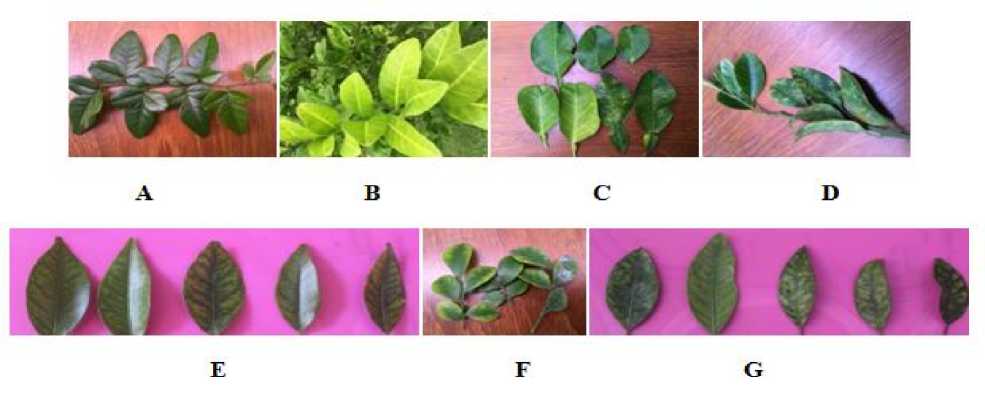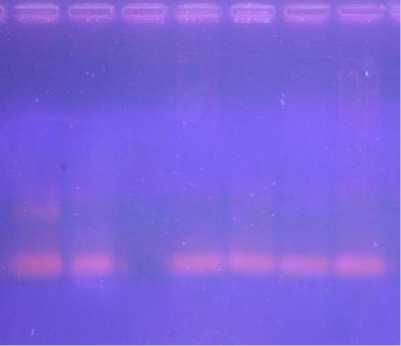DISTRIBUTION OF CVPDr GENE AMONG SOME CITRUS PLANTS IN BALI
on
Note
DISTRIBUTION OF CVPDr GENE AMONG SOME CITRUS PLANTS IN BALI
I Gede Putu Wirawan 1*
1Central Laboratory for Genetic Resources and Molecular Biology, Udayana University, Bali, Indonesia
*Corresponding author: putuwirawan@unud.ac.id or igpwirawan@yahoo.com
ABSTRACT
Citrus Vein Phloem Degeneration (CVPD) is the main disease of citrus plant caused by a Gram negative bacteria, Candidatus Liberobacter asiaticus. The disease is also called citrus greening disease or recently called citrus huanglongbing. The CVPDr gene was firstly found in Triphacia trifoliata a citrus relative plant which considered to be resistant to CVPD disease. The distribution of the gene among the citrus relative plants in Bali were studied. The result of this study so far, CVPDr gene were found in the seedless lime (Citrus aurantiifolia) and Triphacia trifoliata which are known as a resistant or tolerant to CVPD disease, however, Citrus maxima, Citrus nobilis, Citrus reticulate, and Citrus amblycarpa are all sensitive plants but their harboring the CVPDr gene. This result indicated that CVPDr gene was not give a resistant to the disease in these plants. This results suggested that other/s gene is needed to give a resistant or tolerant in these plants.
Citrus Vein Phloem Degeneration (CVPD) disease or huanglongbing is the main disease of citrus plantation in everywhere in the world. The causative agent of the disease is Candidatus Liberobacter asiaticus and it were spreaded by insect vector Diaphorina citri or through aculus bud (Tirtawijaya S., 1981, Sandrine et al, 1996, Wirawan, et al, 2004, Secor G.A., 2009 ). The whole genome of L. asiaticus strain A4 was sequenced by Zeng et al, and reported in 2014. The bacteria was unable to be cultured in vitro and its was present in the phloem of the citrus plants (Sandrine et al, 1996). Many study tried to find how to control the pathogen and to control the insect vector, including the use of gene resistant to the disease. Gene resistant to CVPD disease or huanglongbing has been reported by (Nariani T.K. 1981, ). Our
previous study on Triphacia trifoliata a citrus relative which considered to resistant to the disease, found harboring the candidatus gene that resistant to CVPD disease (Wirawan, et al, 2004, Wirawan I G.P. and Ketut Sri M. J., 2015). The gene is called CVPDr gene was isolated by in vitro plant mutation. One mutant among almost 7000 Triphacia trifoliata mutants found to be sensitive to CVPD disease. Using this mutant the CVPDr gene was isolated by using IPCR technique. This study tried to see the distribution of CVPDr gene among citrus plants or their relative. The plants used in this study were Triphasia trifoliate, Citrus aurantiifolia, Citrus maxima, Citrus nobilis, Citrus reticulate, and Citrus amblycarpa . The DNA was isolated from the leaves of citrus plants studied, and the DNA isolation was using NucleoSpin®Plant II
(Macherey-Nagel). The total DNA from those plants were then subjected to a polymerase chain reaction (PCR) to amplify the fragment CVPDr gene using a AmpliTaq Gold®360 Master Mix from Applied Biosystems. The results of this study show that CVPDr gene were shown in almost all plant studied (Fig. 1). The result of this study showed that CVPDr gene were found in all plant tested except in one plant, Murraya sp.(a negative control plant). The result indicated that the gene was not fully resistant to the CVPD disease in Citrus maxima, Citrus nobilis, Citrus reticulate, and Citrus amblycarpa . The plants that showing resistant to the disease were seedless lime (Citrus aurantiifolia) and Triphacia trifoliata. We do not know yet why, it could due to the polymorphism of the gene or to be resistant need other/s gene to involve in those plants. The comparison of the CVPD disease symptom among plants studied were also shown in Fig. 2. The rate of the symptom
observed in this study were varied among the plants, it could be due to the polymorphism of the gene as well. So that, for the further study we will study these all possibilities.
Citrus amblycarpa

Fig. 2. Various CVPD disease sysmptom in the citrus plants. A. Triphacia trifoliata, B. Seedless lime (Citrus aurantiifolia), C. Citrus maxima, D. Citrus reticulate, E. Citrus nobilis, F. Murraya sp, G. Citrus amblycarpa
1 2 3 4 5 6 7

841 bp
Fig. 1. Distribution of CVPDr gene among
various citrus plants. Lanes 1. Triphacia
trifoliate, 2. Seedless lime (Citrus aurantiifolia), 3.
Murraya sp.( as a negative control), 4. Citrus maxima, 5. Citrus nobilis, 6. Citrus reticulate, 7.
INTERNATIONAL JOURNAL OF BIOSCIENCE AND BIOTECHOLOGY • VOL. IIi NO. 2 • APRIL 2016 ISSN: 9 772302 257 000
ISSN ONLINE: 9 772303 337 008
ACKNOWLEDGEMENT
The study was supported by part the Research Fund of Udayana University, No. 641-108/UN14.2/PNL.01.03.00/2016
REFFERENCES
Kumagai, L.B., C.S. LeVesque, C.L.
Blomquist, K. Madishetty, Y. Guo, P.W. Woods, and S. Rooney-Latham, J. Rascoe, T. Gallindo, D. Schnabel, and M. Polek. 2014. First Report of Candidatus Liberibacter asiaticus Associated with Citrus Huanglongbing in California 2013. Plant Disease 97(2): 283.1.
Nariani,T.K.1981. Integrated approach to control citrus greening disease in India. Proc. Int. Soc. Citriculture. P. 471-472
Sandrine, J,. J. M. Bove, and Garnier. 1996. PCR Detetion of The Two Candidatus Liberobacter Species Associated with Greening Disease of Citrus. Moleculer and celluler probes, 10 : 43
Secor GA, Rivera VV, Lee IM, Clover GRG, Liefting LW, Li X, De Boer SH (2009) Association of ‘Candidatus Liberibacter solanacearum’ with Zebra chip disease of potato established by graft and psyllid transmission, electron microscopy, and PCR. Plant Disease 93(6), 574-583.
Tirtawidjaya, S. 1981. Insect, Dodder and Seed Transmissions of Citrus VeinPhloem Degeneration (CVPD).
Proc.Int.Soc.Criticulture 1: 469-471
Wirawan, IGP., Liliek S., dan Wijaya IN. 2004. Penyakit CVPD Pada Tanaman Jeruk. Denpasar. Udayana University Press.
Wirawan, I Gede Putu and Ketut Sri Marhaeni Juliasih, 2015. Detection of Citrus vein Phloem Degeneration Disease in Citrus Plants by PCR and Protein Analysis using SDS PAGE (A Review). International Journal of Bioscience and Biotechnology, Vol. III, No. 1 2015
Zheng Z, Deng X.and Chen J., 2014. WholeGenome Sequence of “Candidatus Liberibacter asiaticus” from Guangdong, China. Genome Announc. 2014 Mar-Apr; 2(2): e00273-14. Published online 2014 Apr 10. doi:
10.1128/genomeA.00273-14 PMCID: PMC3983304
104 • asia oceania bioscience and biotechnology consortium
Discussion and feedback